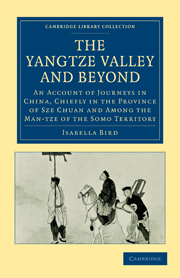 The Yangtze Valley and Beyond
The Yangtze Valley and Beyond Book contents
- Frontmatter
- PREFACE
- Contents
- LIST OF ILLUSTRATIONS
- ERRATA
- CHAPTER I GEOGRAPHICAL AND INTRODUCTORY
- CHAPTER II “THE MODEL SETTLEMENT”
- CHAPTER III HANGCHOW
- CHAPTER IV THE HANGCHOW MEDICAL MISSION HOSPITALS
- CHAPTER V SHANGHAI TO HANKOW (HANKAU)
- CHAPTER VI THE FOREIGNERS—HANKOW AND BRITISH TRADE
- CHAPTER VII CHINESE HANKOW (HANKAU)
- CHAPTER VIII HANKOW TO ICHANG
- CHAPTER IX ICHANG
- CHAPTER X THE UPPER YANGTZE
- CHAPTER XI RAPIDS OF THE UPPER YANGTZE
- CHAPTER XII RAPIDS AND TRACKERS
- CHAPTER XIII LIFE ON THE UPPER YANGTZE
- CHAPTER XIV THE YANGTZE AND KUEI FU
- CHAPTER XV NEW YEAR'S DAY AT KUEI-CHOW FU
- CHAPTER XVI KUEI FU TO WAN HSIEN
- CHAPTER XVII CHINESE CHARITIES
- CHAPTER XVIII FROM WAN HSIEN TO SAN TSAN-PU
- CHAPTER XIX SZE CHUAN TRAVELLING
- CHAPTER XX SAN-TSAN-PU TO LIANG-SHAN HSIEN
- CHAPTER XXI LIANG-SHAN HSIEN TO HSIA-SHAN-PO
- CHAPTER XXII HSIA-SHAN-PO TO SIAO-KIAO
- CHAPTER XXIII SIAO-KIAO TO HSIEH-TIEN-TZE
- CHAPTER XXIV HSIEH-TIEN-TZE TO PAONING FU
- CHAPTER XXV PAONING FU AND SIN-TIEN-TZE
- CHAPTER XXVI SIN-TIEN-TZE TO TZE-TUNG HSIEN
- CHAPTER XXVII TZE-TUNG HSIEN TO KUAN HSIEN
- CHAPTER XXVIII KUAN HSIEN AND CHENGTU
- CHAPTER XXIX KUAN HSIEN TO SIN-WEN-PING
- CHAPTER XXX SIN-WEN-PING TO LI-FAN TING
- CHAPTER XXXI LI-FAN TING TO TSA-KU-LAO
- CHAPTER XXXII THE “BEYOND”
- CHAPTER XXXIII THE MAN-TZE, I-REN, OR SHAN-SHANG-REN
- CHAPTER XXXIV FROM SOMO TO CHENGTU FU
- CHAPTER XXXV DOWNWARD BOUND
- CHAPTER XXXVI LUCHOW TO CHUNG-KING FU
- CHAPTER XXXVII THE JOURNEY'S END
- CHAPTER XXXVIII THE OPIUM POPPY AND ITS USE
- CHAPTER XXXIX NOTES ON PROTESTANT MISSIONS IN CHINA
- CONCLUDING REMARKS
- ITINERARY
- APPENDICES
- INDEX
- Plate section
CHAPTER XXXI - LI-FAN TING TO TSA-KU-LAO
Published online by Cambridge University Press: 05 July 2011
- Frontmatter
- PREFACE
- Contents
- LIST OF ILLUSTRATIONS
- ERRATA
- CHAPTER I GEOGRAPHICAL AND INTRODUCTORY
- CHAPTER II “THE MODEL SETTLEMENT”
- CHAPTER III HANGCHOW
- CHAPTER IV THE HANGCHOW MEDICAL MISSION HOSPITALS
- CHAPTER V SHANGHAI TO HANKOW (HANKAU)
- CHAPTER VI THE FOREIGNERS—HANKOW AND BRITISH TRADE
- CHAPTER VII CHINESE HANKOW (HANKAU)
- CHAPTER VIII HANKOW TO ICHANG
- CHAPTER IX ICHANG
- CHAPTER X THE UPPER YANGTZE
- CHAPTER XI RAPIDS OF THE UPPER YANGTZE
- CHAPTER XII RAPIDS AND TRACKERS
- CHAPTER XIII LIFE ON THE UPPER YANGTZE
- CHAPTER XIV THE YANGTZE AND KUEI FU
- CHAPTER XV NEW YEAR'S DAY AT KUEI-CHOW FU
- CHAPTER XVI KUEI FU TO WAN HSIEN
- CHAPTER XVII CHINESE CHARITIES
- CHAPTER XVIII FROM WAN HSIEN TO SAN TSAN-PU
- CHAPTER XIX SZE CHUAN TRAVELLING
- CHAPTER XX SAN-TSAN-PU TO LIANG-SHAN HSIEN
- CHAPTER XXI LIANG-SHAN HSIEN TO HSIA-SHAN-PO
- CHAPTER XXII HSIA-SHAN-PO TO SIAO-KIAO
- CHAPTER XXIII SIAO-KIAO TO HSIEH-TIEN-TZE
- CHAPTER XXIV HSIEH-TIEN-TZE TO PAONING FU
- CHAPTER XXV PAONING FU AND SIN-TIEN-TZE
- CHAPTER XXVI SIN-TIEN-TZE TO TZE-TUNG HSIEN
- CHAPTER XXVII TZE-TUNG HSIEN TO KUAN HSIEN
- CHAPTER XXVIII KUAN HSIEN AND CHENGTU
- CHAPTER XXIX KUAN HSIEN TO SIN-WEN-PING
- CHAPTER XXX SIN-WEN-PING TO LI-FAN TING
- CHAPTER XXXI LI-FAN TING TO TSA-KU-LAO
- CHAPTER XXXII THE “BEYOND”
- CHAPTER XXXIII THE MAN-TZE, I-REN, OR SHAN-SHANG-REN
- CHAPTER XXXIV FROM SOMO TO CHENGTU FU
- CHAPTER XXXV DOWNWARD BOUND
- CHAPTER XXXVI LUCHOW TO CHUNG-KING FU
- CHAPTER XXXVII THE JOURNEY'S END
- CHAPTER XXXVIII THE OPIUM POPPY AND ITS USE
- CHAPTER XXXIX NOTES ON PROTESTANT MISSIONS IN CHINA
- CONCLUDING REMARKS
- ITINERARY
- APPENDICES
- INDEX
- Plate section
Summary
The sixty li from Li-fan Ting to Tsa-ku-lao (spelled by Mr. von Rosthorn of the Imperial Customs in a letter to me Tsaku-nao) have much the same characteristics as those of the day before. The scenery is magnificent, and even more fantastic. Nitrate of soda, sulphur, and iron-one abound. Sand-stone has disappeared, giving place to limestone, conglomerate, schistaceous rock, grey and pink granite, basalt, and mica. The Siao Ho, still a full-watered and vigorous stream, occasionally narrowed to forty feet, plunges over pink granite ledges in a series of cataracts as the canyon opens out, and there are smooth, green lawns, with much wealth of dwarf, crimson roses, and much gloom, in many graves and dismal remains of Man-tze houses partially destroyed. Some of the pot-holes in the river are remarkable for their size, and still contain the smoothly-rounded stones by the action of which they have been formed. Pine woods appeared on hill crests and on the northern slopes of mountains.
Many Man-tze villages, now deserted, are ready for occupation, and others in romantic situations, now occupied by Chinese, are very striking architecturally, each with a Man-tze feudal castle piled on a rock above it. These villages were always built at the mouths of gorges where lateral torrents joining the Siao Ho formed alluvial fans with arable soil enough to support small populations.
- Type
- Chapter
- Information
- The Yangtze Valley and BeyondAn Account of Journeys in China, Chiefly in the Province of Sze Chuan and Among the Man-tze of the Somo Territory, pp. 395 - 403Publisher: Cambridge University PressPrint publication year: 2010First published in: 1899


